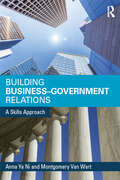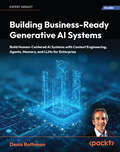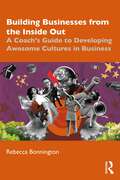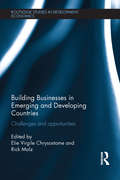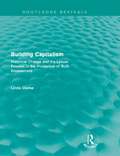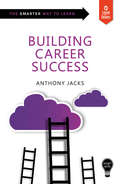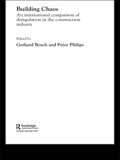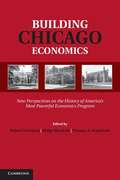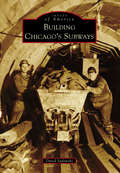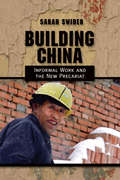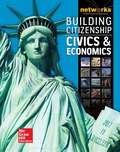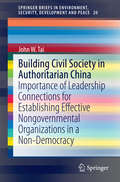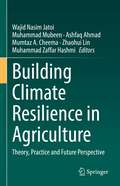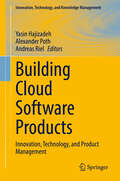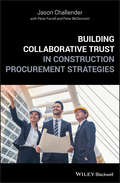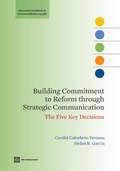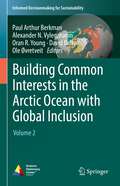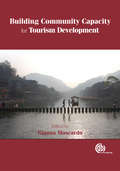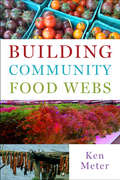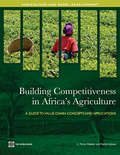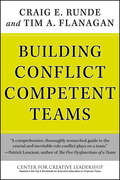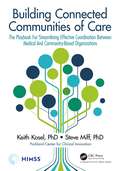- Table View
- List View
Building Business-Government Relations: A Skills Approach
by Montgomery Van Wart Anna NiThis book introduces business-government relations in the institutional context of the United States from a practitioner’s perspective. It provides the historical, descriptive, and comparative accounts of the public and private sectors, the different roles government plays with business, including several conceptual models to understand the social interactions between the two sectors, and various economic policies associated with business. Business-government relations are framed into three different social economic contexts: The sociopolitical arena, in which government’s role as agent of business, interest groups, and government’s limited role as social architect, are introduced. The local economic development, in which government acts as a promoter of, partner with, and buyer from, business. The global market, where government mainly plays a role as promoter of domestic business. In the course of discussion, a set of skills, such as searching government jobs, starting a business, analyzing stakeholders, ethical reasoning, advancing a business agenda, leveraging public resources, contracting with government, interpreting global trends, doing business abroad, and leveraging international resources, are introduced and exercised.
Building Business-Ready Generative AI Systems: Build Human-Centered Generative AI Systems with Agents, Memory, and LLMs for Enterprise
by Denis RothmanSupercharge your business with context-aware AI controllers, adaptive agents, multimodal reasoning functionality, neuroscientific memory systems, and flexible handler mechanisms that integrate the emerging generative AI models. Get with your book: PDF copy, AI Assistant, and Next-Gen Reader free.Key FeaturesBuild an adaptive, context-aware AI controller with advanced memory strategiesEnhance GenAISys with multi-domain, multimodal reasoning capabilities and Chain of Thought (CoT)Seamlessly integrate cutting-edge OpenAI and DeepSeek models as you see fitBook DescriptionIn today's rapidly evolving AI landscape, standalone LLMs no longer deliver sufficient business value on their own. This guide moves beyond basic chatbots, showing you how to build advanced, agentic ChatGPT-grade systems capable of sophisticated semantic and sentiment analysis, powered by context-aware AI controllers. You'll design AI controller architectures with multi-user memory retention to dynamically adapt your system to diverse user and system inputs. You'll architect a Retrieval-Augmented Generation (RAG) system with Pinecone, designed to combine instruction-driven scenarios. Enhance your system’s intelligence with powerful multimodal capabilities—including image generation, voice interactions, and machine-driven reasoning—leveraging Chain-of-Thought orchestration to address complex, cross-domain automation challenges. Seamlessly integrate generative models like OpenAI’s suite and DeepSeek-R1 without disrupting your existing GenAISys ecosystem. Your GenAISys will apply neuroscience-inspired insights to marketing strategies, predict human mobility, integrate smoothly into human workflows, visualize complex scenarios, and connect to live external data, all wrapped in a polished, investor-ready interface. By the end, you'll have built a GenAISys capable of deploying intelligent agents in your business environment.What you will learnImplement an AI controller with a conversation AI agent and orchestrator at its coreBuild contextual awareness with short-term, long-term, and cross-session memoryDesign cross-domain automation with multimodal reasoning, image generation, and voice featuresExpand a CoT agent by integrating consumer-memory understandingIntegrate cutting-edge models of your choice without disrupting your existing GenAISysConnect to real-time external data while blocking security breachesWho this book is forThis book is for AI and Machine Learning Engineers seeking to enhance their understanding of Generative AI and its enterprise applications. It will particularly benefit those interested in building AI agents, creating advanced orchestration systems, and leveraging AI for automation in marketing, production, and logistics. Software architects and enterprise developers looking to build scalable AI-driven systems will also find immense value in this guide. No prior superintelligence experience is necessary, but familiarity with AI concepts is recommended.
Building Businesses from the Inside Out: A Coach’s Guide to Developing Awesome Cultures in Business
by Rebecca BonningtonAs businesses grow, culture can be created by accident or by design. This book is for coaches and consultants who want to support their clients to design their culture.Coaches can struggle to devise simple and useful content, especially if they are new to coaching. This book gives clear models and frameworks as well as the steps to deliver those frameworks to their clients. Based on the popular Kick A** Culture Coach Program, it is full of new ideas, tried and tested models, and thoughts on how to develop a deeper relationship with clients through retained programs. Unique to this book are the links provided to online courses, with each chapter including a link to an online course which helps to embed learning and gives access to downloadable materials, such as video, audio, and high quality, professionally designed PDFs suitable for workshops, presentations, and coaching sessions.This book is a comprehensive resource for experienced business coaches and consultants to add to their toolkits, as well as aspiring coaches and consultants who need frameworks to get started – and it’s helpful for business owners too.
Building Businesses in Emerging and Developing Countries: Challenges and Opportunities (Routledge Studies in Development Economics #111)
by Elie Virgile Chrysostome Rick MolzThis book focuses on the challenges and opportunities facing companies in emerging and developing countries. China and India have become the primary business destination for many global companies that are looking for market opportunities and low costs of production, whilst Morocco, Dubai, Brazil, Malaysia and Russia are also being targeted. This new edited volume helps develop a better understanding of the realities of doing business in emerging and developing countries, in particular exploring the dynamics between corporations – both indigenous and multinational – and local pressures in developing, transitional and emerging economies. The book points out the benefits and pitfalls of doing business in emerging and developing countries, as well as the adjustments that are necessary for success. It also discusses entrepreneurship in emerging and developing countries, exploring its new realities from women’s entrepreneurship in Muslim countries to social entrepreneurship in developing countries. The volume also points out the new challenges for SMEs of emerging and developing countries in a global competitive environment. Finally, it analyses corporate governance from a local partner perspective and an institutional perspective. Building Businesses in Emerging and Developing Countries will be of interest to business managers, students and researchers involved in international entrepreneurship and corporate governance.
Building Capitalism: Historical Change and the Labour Process in the Production of Built Environment (Routledge Revivals)
by Linda ClarkeFirst published in 1992, this Routledge Revival sees the reissue of a truly original exploration of the nature of urbanization and capitalism. Linda Clarke’s vital work argues that: Urbanization is a product of the social human labour engaged in building as well as a concentration of the labour force. The quality of the labour process determines the development of production. Changes to the built environment reflect changes in the production process and, in particular, the development of wage labour. To support these arguments, the author identifies a qualitatively new historical stage of capitalist building production involving a significant expansion of wage labour, and hence capital, and the transition from artisan to industrial production. Linda Clarke draws from a wide range of original material relating to the development of London from the mid-eighteenth to the early nineteenth century to provide a complete description of the development process: materials extraction, roadbuilding, housebuilding, paving, cleansing, etc; profiles of builders and contractors involved, and a picture of the new working class communities, as in Somers Town – their living conditions, population, working environment, and politics.
Building Career Success (Smart Skills)
by Anthony JacksThis book will show you how to build the skills that will make you a more successful professional, such as developing your skills and competencies, working and partnering with your your employer, building strong organizational relationships and increasing your visibility, thriving in your organization's culture, and increasing and applying your business knowledge. It will enable you to achieve peak performance and success by understanding and capitalizing on your strengths and minimizing your weaknesses.
Building Chaos: An International Comparison of Deregulation in the Construction Industry (Routledge Studies In Business Organizations And Networks Ser. #Vol. 22)
by Gerhard Bosch Peter PhilipsThis collection draws on international comparisons from the main industrialized countries in a key field - the construction industry. One only has to walk around almost any major city in the industrialized economies of the world to see how well the construction industry is doing and this study is a timely analysis of a growing field.This genuinely
Building Chicago Economics
by Rob Van Horn Philip Mirowski Thomas A. StaplefordOver the past forty years, economists associated with the University of Chicago have won more than one-third of the Nobel prizes awarded in their discipline and have been major influences on American public policy. Building Chicago Economics presents the first collective attempt by social science historians to chart the rise and development of the Chicago School during the decades that followed the Second World War. Drawing on new research in published and archival sources, contributors examine the people, institutions and ideas that established the foundations for the success of Chicago economics and thereby positioned it as a powerful and controversial force in American political and intellectual life.
Building China: Informal Work and the New Precariat
by Sarah SwiderRoughly 260 million workers in China have participated in a mass migration of peasants moving into the cities, and construction workers account for almost half of them. In Building China, Sarah Swider draws on her research in Beijing, Guangzhou, and Shanghai between 2004 and 2012, including living in an enclave, working on construction jobsites, and interviews with eighty-three migrants, managers, and labor contractors. This ethnography focuses on the lives, work, family, and social relations of construction workers. It adds to our understanding of China's new working class, the deepening rural-urban divide, and the growing number of undocumented migrants working outside the protection of labor laws and regulation. Swider shows how these migrants--members of the global "precariat," an emergent social force based on vulnerability, insecurity, and uncertainty--are changing China's class structure and what this means for the prospects for an independent labor movement. The workers who build and serve Chinese cities, along with those who produce goods for the world to consume, are mostly migrant workers. They, or their parents, grew up in the countryside; they are farmers who left the fields and migrated to the cities to find work. Informal workers--who represent a large segment of the emerging workforce--do not fit the traditional model of industrial wage workers. Although they have not been incorporated into the new legal framework that helps define and legitimize China's decentralized legal authoritarian regime, they have emerged as a central component of China's economic success and an important source of labor resistance.
Building Cities: A Technical Note
by Arthur I Segel Oliver O. HartlebenWorld population growth and increasing urbanization will require new cities in the future around the world. This technical note attempts to systematize the key design decisions that developers and policy makers alike must make to be able to proceed.
Building Citizenship: Civics & Economics
by John J. Patrick Richard C. Remy David C. SaffellNIMAC-sourced textbook
Building Citizenship: Civics & Economics
by John J. Patrick Richard C. Remy David C. SaffellNIMAC-sourced textbook
Building Civil Society in Authoritarian China: Importance of Leadership Connections for Establishing Effective Nongovernmental Organizations in a Non-Democracy (SpringerBriefs in Environment, Security, Development and Peace #20)
by John W. TaiHow is modern civil society created? There are few contemporary studies on this important question and when it is addressed, scholars tend to emphasize the institutional environment that facilitates a modern civil society. However, there is a need for a new perspective on this issue. Contemporary China, where a modern civil society remains in a nascent stage, offers a valuable site to seek new answers. Through a comparative analysis of nongovernmental organizations (NGOs) in today's China, this study shows the importance of the human factor, notably the NGO leadership, in the establishment of a modern civil society. In particular, in recognition of the social nature of NGOs, this study engages in a comparative examination of Chinese NGO leaders' state linkage, media connections and international ties in order to better understand how each factor contributes to effective NGOs.
Building Climate Resilience in Agriculture: Theory, Practice and Future Perspective
by Muhammad Zaffar Hashmi Zhaohui Lin Wajid Nasim Jatoi Muhammad Mubeen Ashfaq Ahmad Mumtaz Akhtar CheemaThis volume discusses the need to adopt Climate-Resilient Agriculture (CRA) practices to address the increasing global impact that climate change has on agricultural productivity and agriculture-dependent communities. This approach applies technological, policy and economic measures to achieve sustainable agricultural growth in the sectors of grain, fruit, vegetable, fiber, feed, livestock, fisheries and forestry, with the ultimate goal of adapting and building resilience to climate change. The book also uses GIS, crop modeling and remote sensing techniques for future climate resilience applications in agriculture, and covers pest control measures that avoid the use of pesticides to boost crop and livestock productivity for improved food security. The book will be of interest to researchers and students in environmental science, climate science, sustainability and agriculture, as well as policy makers and environmental organizations.
Building Cloud Software Products: Innovation, Technology, and Product Management (Innovation, Technology, and Knowledge Management)
by Alexander Poth Andreas Riel Yasin HajizadehCloud-native approaches have become essential in IT and OT product development. Cloud-native is more than using the newest cutting-edge services from hyperscalers. Building cloud products benefits from a holistic approach beyond focusing on an isolated cloud paradigm. This book addresses the different aspects of designing, building, and running cloud software products and services from a holistic perspective. It investigates how to empower cloud product and service teams to consider the relevant aspects for long-term success. It provides an overview of selected technologies and practical adoptions and explores various requirements to maintain economic and environmental sustainability. It examines the challenges faced by product management teams of cloud providers, independent software vendors (ISVs), and system integrators (SIs) and offers potential solutions. The chapters also showcase internal success stories and case studies of various companies during the lifecycle of a cloud product. Offering a combination of advanced research from academia and practical industry lessons learned, this book empowers cloud product and service teams to consider and adopt various ideas, concepts, and methods to provide successful, high-quality cloud products and services.
Building Coalitions
by Herminia Ibarra Jennifer M. SuesseIntroduces students to Peter Black's tactical approach toward building coalitions.
Building Collaborative Trust in Construction Procurement Strategies: A Practical Guide
by Peter Farrell Jason Challender Peter McDermottProvides a practical framework and toolkit for improved construction project outcomes based on trust and collaboration This book explores the concept of trust as a tool in improved construction procurement strategies, and provides important insight into the influence of trust on the success of construction projects and redevelopment programs. It is a practical guide that offers readers a solid outline and expert strategies for improving project outcomes through collaboration—ultimately proving that teamwork can really make the dream work. Building Collaborative Trust in Construction Procurement Strategies: A Practical Guide incorporates a toolkit, complete with flowcharts, to introduce certain trust building interventions within projects. It shows how initiatives and factors that influence collaborative trust can be easily implemented and embedded in construction management for improved practice. It also covers potential challenges, risks, problems, and barriers when it comes to trust. In addition, the book looks at the influences for collaborative trust in the construction industry as well as implications in practice for it in construction. It finishes by looking at the future of collaborative trust in construction procurement. Teaches the importance and influence of trust on collaborative working and partnerships principles Examines to what extent trust within collaborative working arrangements influences the success of collaborative working practices Covers the effect that certain factors and trust building mechanisms have on collaborative working and partnerships and how they can be embedded into procurement of projects Discusses what constitutes best practice and how trust in collaborative procurement practices influences the success of construction projects Building Collaborative Trust in Construction Procurement Strategies: A Practical Guide is an excellent book for construction management professionals, including clients, consultants, and contractors. It will also serve as a helpful text for undergraduate and postgraduate students and academics.
Building Commitment to Reform through Strategic Communication
by Helen R. Garcia Cecilia Cabañero-VerzosaStrategic communication is a powerful tool for creating broad-based support for reform and change initiatives. Much has been written about why communication matters in reform efforts, but there is scant material available to help those who manage reforms apply communication concepts and approaches to their own programs and policy-reform initiatives. 'Building Commitment to Reform through Strategic Communication' attempts to bridge that gap. The authors present a pragmatic and systematic approach for reformers ready to use communication strategically to achieve their reform goals. The Five Communication Management Decision Tool helps reformers and their teams develop a framework for their communication strategies. This decision tool helps managers see change initiatives through the eyes of those who will be affected by the reforms. When the decision tool is used in the early stages of the development of change programs, reformers gain an even deeper understanding of the stakeholders' perspectives on the reforms, which influence stakeholder opposition or support for them. Such understanding will not only be instructive, but possibly transformative-for both change agents and those stakeholders whose support is critical to the success of reform. Reform agents may recognize the source of stakeholder resistance and be able to revise reform goals and redesign change interventions. Stakeholders who have a shared understanding of why the status quo is not acceptable and change is necessary are more likely to create coalitions of committed allies and supporters who will work together to achieve reform goals. This workbook illustrates how the decision tool can be used for various types of change and reform initiatives-from policy reform, to country and donor partnership agreements, to sectoral reforms. Tested and used in learning interventions across cultures, regions, and sectors, the tool has been used successfully by teams in government, nongovernmental organizations, the business sector, and donor agencies. The book will be of great interest to readers working in all of these areas.
Building Common Interests in the Arctic Ocean with Global Inclusion: Volume 2 (Informed Decisionmaking for Sustainability)
by Oran R. Young Paul Arthur Berkman Alexander N. Vylegzhanin David A. Balton Ole Rasmus ØvretveitThis book contains an inclusive compilation of perspectives about the Arctic Ocean with contributions that extend from Indigenous residents and early career scientists to Foreign Ministers, involving perspectives across the spectrum of subnational-national-international jurisdictions. The Arctic Ocean is being transformed with global climate warming into a seasonally ice-free sea, creating challenges as well as opportunities that operate short-to-long term, underscoring the necessity to make informed decisions across a continuum of urgencies from security to sustainability time scales. The Arctic Ocean offers a case study with lessons that are especially profound at this moment when humankind is exposed to a pandemic, awakening a common interest in survival across our globally-interconnected civilization unlike any period since the Second World War. This second volume in the Informed Decisionmaking for Sustainability series reveals that building global inclusion involves common interests to address changes effectively “for the benefit of all on Earth across generations.”
Building Community Capacity for Tourism Development
by Gianna MoscardoTourism has become an important tool for development in rural, remote and peripheral regions in the last 50 years. However, in many places, tourism has failed to produce the promised benefits and often caused negative impacts due to a lack of local entrepreneurial capacity to benefit from tourism business opportunities, inadequate understanding of tourism markets and limited community awareness of tourism and its impacts. Drawing attention to the potential outcomes to communities when using tourism as a development strategy, this book provides a focused analysis of this emerging issue and positive guidance on improving the process of tourism planning and development. Chapters compile evidence and examples of how community capacity for tourism can be built and enhanced using case studies from Asia, Africa, South America, the South Pacific and rural Australia and the United States. Providing models and frameworks that can be applied to any developing area, this book will be useful to both academic researchers and government policy makers interested in tourism and rural development.
Building Community Food Webs
by Ken MeterOur current food system has decimated rural communities and confined the choices of urban consumers. Even while America continues to ramp up farm production to astounding levels, net farm income is now lower than at the onset of the Great Depression, and one out of every eight Americans faces hunger. But a healthier and more equitable food system is possible. In Building Community Food Webs, Ken Meter shows how grassroots food and farming leaders across the U.S. are tackling these challenges by constructing civic networks. Overturning extractive economic structures, these inspired leaders are engaging low-income residents, farmers, and local organizations in their quest to build stronger communities.Community food webs strive to build health, wealth, capacity, and connection. Their essential element is building greater respect and mutual trust, so community members can more effectively empower themselves and address local challenges. Farmers and researchers may convene to improve farming practices collaboratively. Health clinics help clients grow food for themselves and attain better health. Food banks engage their customers to challenge the root causes of poverty. Municipalities invest large sums to protect farmland from development. Developers forge links among local businesses to strengthen economic trade. Leaders in communities marginalized by our current food system are charting a new path forward.Building Community Food Webs captures the essence of these efforts, underway in diverse places including Montana, Hawai&‘i, Vermont, Arizona, Colorado, Indiana, and Minnesota. Addressing challenges as well as opportunities, Meter offers pragmatic insights for community food leaders and other grassroots activists alike.
Building Competitiveness in Africa's Agriculture
by Patrick Labaste C. Martin WebberValue chain-based approaches offer tremendous scope for market-based improvements in production, productivity, rural economy diversification, and household incomes, but are often covered by literature that is too conceptual or heavily focused on analysis. This has created a gap in the information available to planners, practitioners, and value chain participants. Furthermore, few references are available on how these approaches can be applied specifically to developing agriculture in Africa. 'Building Competitiveness in Africa's Agriculture: A Guide to Value Chain Concepts and Applications' describes practical implementation approaches and illustrates them with scores of real African agribusiness case studies. Using these examples, the 'Guide' presents a range of concepts, analytical tools, and methodologies centered on the value chain that can be used to design, implement, and evaluate agricultural and agribusiness development initiatives. It stresses principles of market focus, collaboration, information sharing, and innovation. The 'Guide' begins by examining core concepts and issues related to value chains. A brief literature review then focuses on five topics of particular relevance to African agricultural value chains. These topics address challenges faced by value chain participants and practitioners that resonate through the many cases described in the book. The core of the book presents methodological tools and approaches that blend important value chain concepts with the topics and with sound business principles. The tools and case studies have been selected for their usefulness in supporting market-driven, private-sector initiatives to improve value chains. The 'Guide' offers 13 implementation approaches, presented within the implementation cycle of a value chain program, followed by descriptions of actual cases. Roughly 60 percent of the examples are from Africa, while the rest come from Europe, Latin America, and Asia. The 'Guide' offers useful guidance to businesspeople, policy makers, representatives of farmer or trade organizations, and others who are engaged in agro-enterprise and agribusiness development. These readers will learn how to use value chain approaches in ways that can contribute to sound operational decisions, improved market linkage, and better results for enterprise and industry development.
Building Conflict Competent Teams
by Tim A. Flanagan Craig E. RundeUnderstanding how to cool down, slow down, and engage the naturally occurring conflicts among team members is critical to the ultimate success of a team. With this book, your team and its members will gain a deeper understanding of how conflict emerges and how to respond in ways that will leverage conflicts to their advantage. Team members will learn the importance of establishing a safe team climate, agreeing on processes to guide interactions, and use of constructive communication skills in order to develop a conflict competent team.As the authors say, conflict is not to be avoided, but embraced and explored. This often results in new, previously unimagined opportunities, solutions and results. The authors include stories, interviews, and examples that provide entertaining and thought provoking insights. They dedicate one chapter to techniques and processes for addressing team conflict that has gone awry. Runde and Flanagan also include useful tips and tools for assessing your team?s current state of conflict competence and suggestions for addressing the challenges of today?s virtual and geographically dispersed teams.
Building Connected Communities of Care: The Playbook For Streamlining Effective Coordination Between Medical And Community-Based Organizations (HIMSS Book Series)
by Keith Kosel Steve MiffAs a community, aligning efforts across a community to support the safety and well-being of vulnerable and underserved individuals is extraordinarily difficult. These individuals suffer disproportionally from health issues, job loss, a lack of stable housing, high utility costs, substance abuse, and homelessness. In addition to medical care, these individuals often critically need access to community social sector organizations that provide a distinct and complementary set of services, such as housing, food services, emergency utility assistance, and employment assistance. These services are just as vital as healthcare services to these individuals’ long-term health and well-being, with data suggesting that 80–90% of health outcomes can be attributed to factors beyond direct medical intervention. This book proposes a novel approach to the coordination of medicine and social services through the use of people, process, and technology, with the goal being to streamline coordination between medical and Community-Based Organizations and to promote true cross-sector patient and client advocacy. The book is based on the experience of Dallas, TX, which was one of the first metropolitan regions to develop a comprehensive foundation for partnership between a community’s clinical and social sectors using web-based information exchange. In the 5 years since the initial launch, the authors have been able to provide seamless connection, communication, and coordination between healthcare providers and a wide array of community-based social service organizations (a/k/a Community-Based Organizations or CBOs), criminal justice entities, and various other community organizations, including non-collegiate educational systems. This practical how-to guide is the codification of transferrable lessons from successes and challenges faced when working with clinical, community, and government leaders. By reading this playbook, leaders interested in building (or expanding) connected clinical-community services will learn how to: 1) facilitate cross-sector care coordination; 2) enable community care partners to better provide targeted services to community residents; 3) reduce duplication of services across partnering organizations; and 4) help to bridge service gaps in the currently fragmented system. Implementation of services, as recommended in this book, will ultimately streamline assistance efforts, reduce repeat crises and emergency funding requests, help address disparities of care, and improve the health, safety, and well-being of the most vulnerable community residents.
